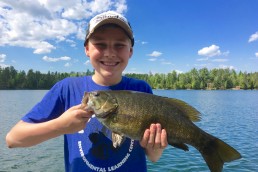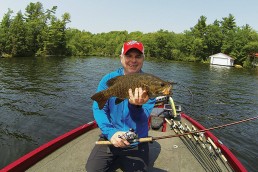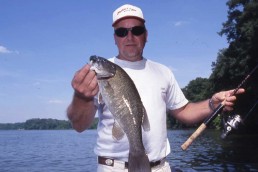Simple Summer Smallmouths: Less is more when targeting bronzebacks
SHARE THIS POST
When browsing through sources of bass-fishing information, it seems there’s always some type of new technique being talked about. Whether you do your tackle shopping at a retail outlet, from a mail order catalog or online, the lure choices available for bass fishing are vast, if not overwhelming. New lures come to market continuously, and some find success and a place while many do not. Regardless, choice is a great thing for an angler and there are times when something new will produce extra bites to conditioned fish. Although summer smallies offer an opportunity for experimenting, if you want to spend more time catching, simplifying your offerings to a handful of proven lures.
The first must-have lure when venturing north for summer smallmouths is a no-brainer—a topwater. The topwater lure and the smallmouth go together like peanut butter and jelly. I’m certain if you asked a group of bronzeback anglers what their favorite way to catch them was, the majority would say with a topwater. But the topwater isn’t on this list because it’s a favorite. It’s here because it flat-out catches them and often better than anything else. Aside from the first and last weeks of my bass season, I don’t ever venture out without a topwater.
Regarding the type, it doesn’t matter much. Sure, the smallies might show a preference for one type, say a popper over a walking bait or a prop bait, but day in and day out, plenty of fish can be had on any of them, so just fish your favorite.
If you’re up north you will no doubt be fishing a fair share of rocks. I’ll mention these next two lures together since, to some extent, they work as a team. These are the suspending jerkbait and the shallow- to medium-diving crankbait. Occasionally, you may catch fish on the same piece of structure with either of these, but normally, the fish will have a preference for one over the other. The dictating factor is the exact location of that fish on the structure you’re targeting. If bass are dispersed across the rock flats and reef tops that are so common here, the crankbait will shine. But if fish are relating to the break where the flat falls off into deeper water, you should then throw the jerkbait.
Most suspending jerkbaits will serve you well. So if you have a favorite, stick with it. I tend to switch up my jerk selection with water-temperature progressions as the summer goes on, eventually ending up in the fall with what I started with in spring. But if I had to pick one jerkbait for July, it would be the Rapala Shadow Rap Deep. It’s been my go-to lure for fishing in late spring to midsummer since it was introduced.
Are you enjoying this post?
You can be among the first to get the latest info on where to go, what to use and how to use it!
As for the crankbait, that will depend on the depth of the flat. In the majority of the lakes I fish, like Rainy and Vermilion, the productive flats tend to occupy that 4- to 8-foot range so you need cranks that will get to at least that. I’m a bit of a crankbait junkie, so there aren’t many I haven’t thrown. But there are a bunch of good ones. If I was only allowed one, it’s a pretty easy choice—a Storm Wiggle Wart.
More days than not, these will be all that you need for summer smallies. But on days when the fish are just a little bit sluggish, a tube will justify its place in your arsenal. Whether it’s post-spawn, post-frontal or for no apparent reason at all, smallmouths will occasionally get a little uncooperative during summer. This where a tube’s versatility is an asset as it can be fished shallow or deep, quickly or slowly, in open water or on the bottom.
The tube has lost some popularity to the drop-shot in the last decade or so, but if there’s a lure that’s caught more smallmouths than any other I wouldn’t be surprised if it’s the tube. These have been essentially unchanged, but have had a little resurgence in recent years largely in part to a slight variation that’s become popular with northern-smallmouth anglers in particular. This is a smaller variety of tube—short in length with larger diameter. These are often referred to as a “fat” tube. I was skeptical at first, but after some time with it, this variant does excel at catching less-than-aggressive smallies. I feel that it’s a combination of its unobtrusive small stature and beefy profile that mimics something worth eating. It also has a slightly subtler spiral on the fall compared to a longer tube, which likely contributes to its effectiveness on lethargic fish. There are several on the market I’ve used, and the one that I’ve settled on is the Impulse Fatty Tube from Northland Tackle. It comes in a couple sizes, but for this situation I like the smaller 2 3/4-inch version. It’s less imposing to a neutral- or negative-minded smallmouth, which makes it easier for it to inhale. And with the combination of the Impulse formula and added salt, a smallie will grab it and not let go. This is key when dealing with fish that are reluctant to bite.
Northern smallmouths this month are generally cooperative and can be caught on a variety of presentations. But if you want to up your odds without dragging a garage full of tackle along, using this group of standouts is all you need.
MWO
SHARE THIS POST
Did you enjoy this post?
You can be among the first to get the latest info on where to go, what to use and how to use it!
Scott Walsh
MidWest Outdoors works with more than 200 outdoor experts each year, who contribute articles based on their areas of expertise. MidWest Outdoors magazine offers more fishing and hunting articles than any other publication!



